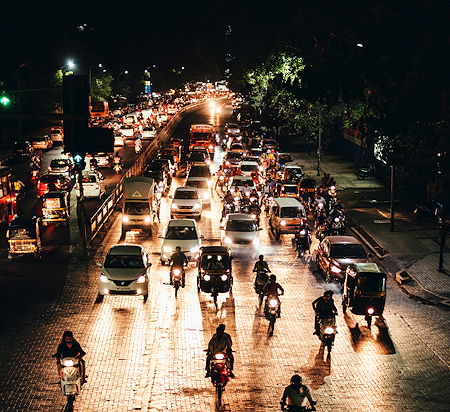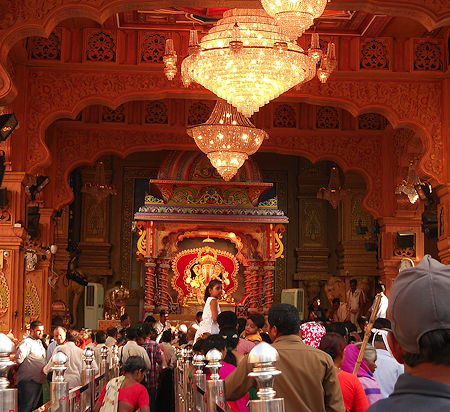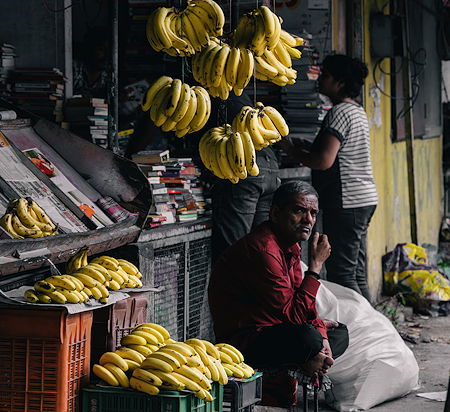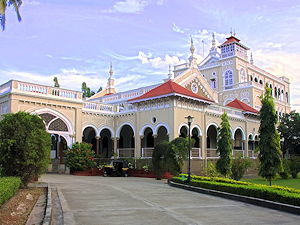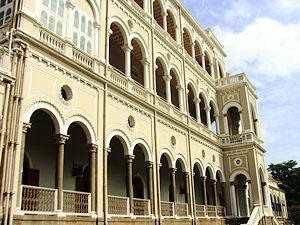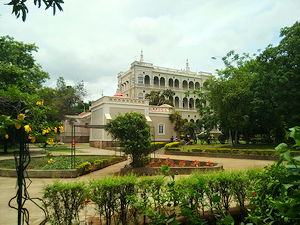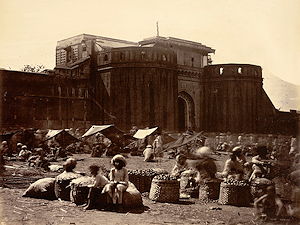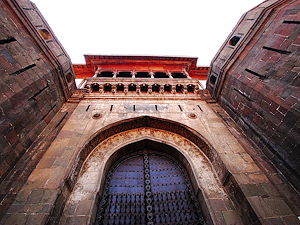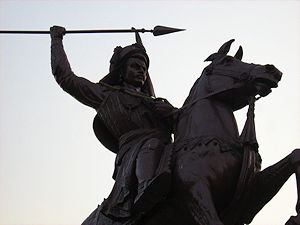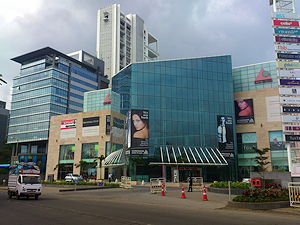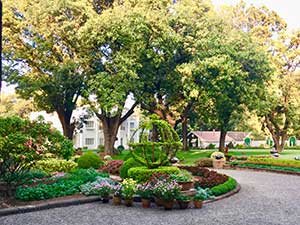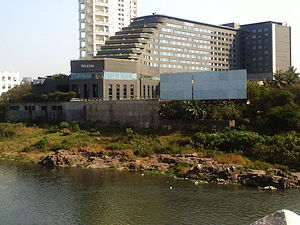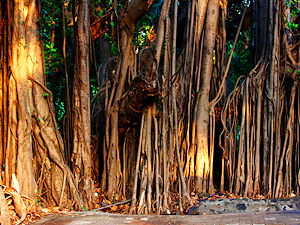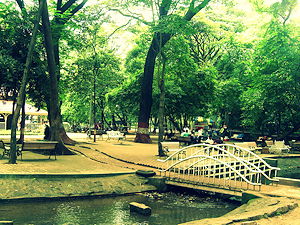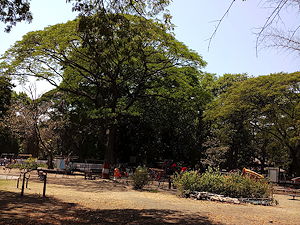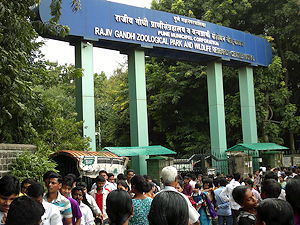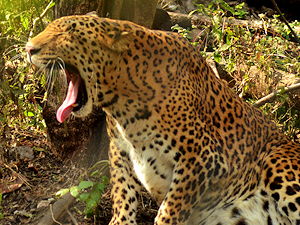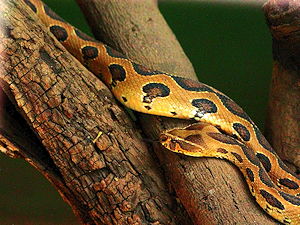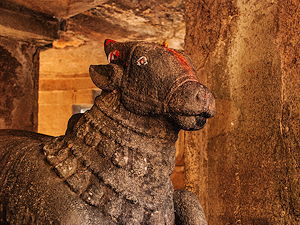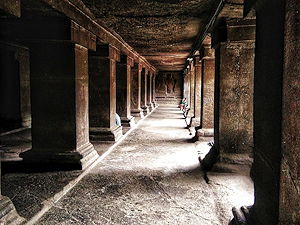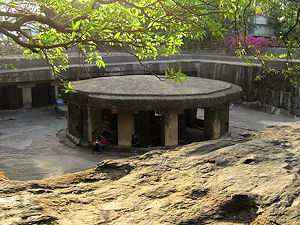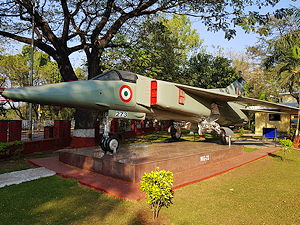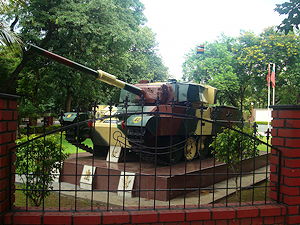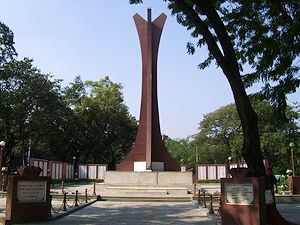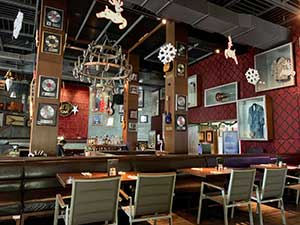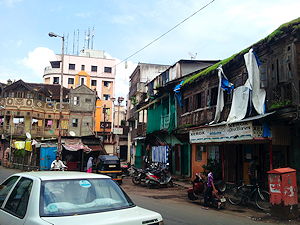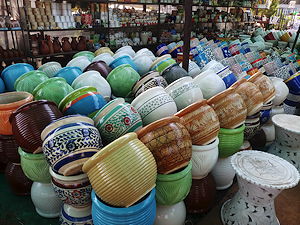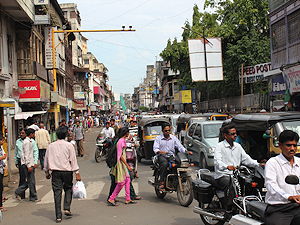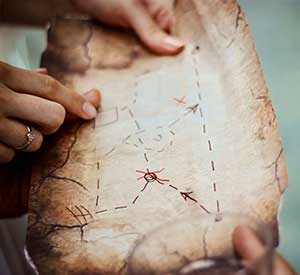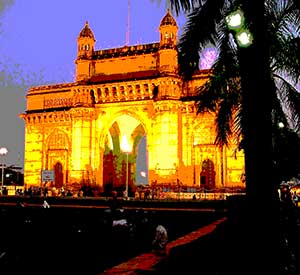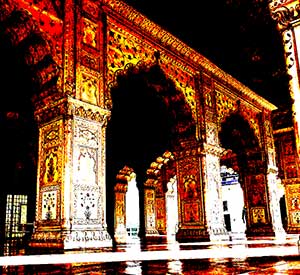Things to do in Pune, India
Pune, the ninth largest city in India, is a sprawling metropolis of noise, pollution, history and natural beauty.
Must-see attractions and things to do include the Aga Khan Palace (where Gandhi was held captive for two years), the Shaniwar Wada (a large fort that was the seat of the Peshwas until the early 19th century), Koregaon Park (Pune's wealthiest district, home to the Osho Meditation Resort and great cafes and restaurants), Pune Zoo (a well maintained zoo and reptile park on the outskirts of town) and the Pataleshwar Cave Temple (often compared with Mumbai's Elephanta Caves).
Pune has natural beauty and a rich history for tourists to discover: it was here that the Peshwas ruled India during the 18th century; that Gandhi was imprisoned by the British once his Quit India movement started gaining popularity; and that rich and famous Indians choose to keep second homes, with Pune sometimes referred to as India's Pensioner's Paradise! A 2017 survey ranked Pune as the second best place to live in India, after Hyderabad and ahead of Mumbai.
Pune is also home to many of India's premier educational establishments, such as Pune University, the National Chemical Laboratory and the National Defence Academy. Half of the foreign students studying in India are to be found in Pune, often dubbed the 'Oxford of the East'. Pune has another claim to fame: it was here that badminton, one of India's favourite sports, was developed.
Located a three hour drive from Mumbai, at a height of 560 metres above sea level (and therefore a few degrees cooler than the Maharashtra state capital), Pune (previously Poona) is home to about 6.25 million people.
Here are the best eight attractions and things to do in Pune.
1. The Aga Khan Palace
The Aga Khan Palace is an important historical attraction: it was here that Ghandi was imprisoned between August 1942 and May 1944.
In addition, it offers splendid and tranquil gardens—making it a great family day out.
The Palace was built between 1892 and 1897 by the Third Aga Khan, Sultan Mohammad Shah Aga Khan. It was commissioned to provide employment for famine-struck local villagers, with more than 1000 people being employed for the five-year period of its construction. The Palace was donated to the Indian state by Prince Karim Aga Khan in 1972.
Gandhi's imprisonment
The Palace is most important for being the place where Mahatma Ghandi, his wife Kasturba, and his secretary, Mahadev Desai, were imprisoned on 9 August 1942. The British authorities took this step because of concerns about the popularity of Gandhi's Quit India movement.
Ghandi's secretary had a fatal heart attack almost immediately, prompting a tense standoff between Gandhi and the authorities regarding his burial. The British eventually relented and permitted Desai's body to be cremated in a corner of the Palace's grounds. Gandhi lit the pyre and said:
Mahadev has lived up to the 'Do or Die' mantra. This sacrifice cannot but hasten the day of India's deliverance.'
Other significant events that took place during Gandhi's imprisonment included Gandhi hoisting the congress flag in January 1943 and January 1944 and the death of Gandhi's wife on 22 February 1944. Ghandi suffered a severe malarial attack six weeks later and was eventually released on 6 May 1944, on account of his failing health: the British thought that the nation would be enraged if he died in prison.
It took a further three years before India gained independence on 15 August 1947. Ghandi was later assassinated by a Hindu nationalist, who thought Gandhi unduly favoured Pakistan, in January 1948. He was cremated and his ashes distributed to a number of locations, including the Aga Khan Palace.
The palace and grounds
The Palace and its grounds occupy around 17 acres. The Palace itself has three storeys, the ground floor occupying almost 2000 square metres (including a wide corridor that allows you to circumnavigate the building).
The internal rooms now house exhibitions devoted to Gandhi's work and a number of his personal items, including cooking utensils, clothes, slippers and a letter written by Gandhi on the death of his secretary. But don't expect a high standard of curatorship: translations are haphazard, the lighting is poor, and many of the photographs are faded.
The grounds, by contrast, are well-maintained and include a number of mature trees including the Tamarind and various palm varieties. The grounds also house the Samadhis (tombs) of Gandhi's wife and secretary and a monument holding some of Gandhi's ashes.
where? Pune Nagar Road, Kalyani Nagar, Pune, Maharashtra 411014.
when? 9.00 am to 5.30 pm. Closed Mondays.
£$€¥ 300 Rupees for foreigners; 25 Rupees for Indians (December 2019)
2. The Shaniwar Wada
The Shaniwar Wada is a large 18th century fort built close to Pune's Mula Mutha river that has an interesting history, impressive fortifications and well-kept gardens.
The Shaniwar Wada (meaning Saturday Residence) was built between 1730 and 1732 at a cost of Rs16,120. It was used as the principal residence of the Peshwa rulers of the Maratha Empire until 1818. As the Peshwas ruled much of modern day India, the fort was home to their retinue of about 1000 people.
The fort's history
In June 1818, the British East India Company seized control of the fort after the conclusion of the Third Anglo-Maratha War and the Peshwa abdicated his throne to Sir John Malcolm (becoming a political prisoner of the British Government).
The fort was largely gutted by fire on 27 February 1828, meaning that visitors have to imagine what the Court Hall of Bajirao-l (the head of the Peshwas when the Shaiwar Wada was constructed), the Dancing Hall and the Old Mirror Hall looked like.
Visiting the fort
But there's still plenty to see. Start with the impressive spiked Delhi Gates (also known as the Dilli Darwaza—you'll have to pass through these to get in). The 72 twelve inch spikes are there to stop elephants from breaking the gates down. The other gates - the Mastani, Khidki, Ganesh and Narayan Darwaza - are no longer in use.
Then take a look around the well-kept gardens that are enclosed by the fort's outer walls. A number of foundations and fountains remain, giving you an idea of the original structure. But, again, the standard of curatorship is not high (though we enjoyed the description of the decidedly unimpressive Hazari Karanje fountain as the world's second best water feature).
Don't miss the opportunity to climb the steep stone stairs that lead to the top of the fort's perimeter. A lap of the wall probably takes about 10 minutes, and is not for the feint-hearted (there are no handrails and there are plenty of children whizzing around). Make sure you climb to the Nagarkhana hall on the top of the Delhi Gate.
where? Shaniwar Peth, Pune, Maharashtra 411030.
when? 8.00am to 6.30pm, seven days a week.
£$€¥ Foreign tourists: Rs125; Indian tourists: Rs5.
3. Koregaon Park
Koregaon Park is Pune's elite district: it is here that many of its top hotels are found, together with plush 'bungalows' owned by the rich and famous.
Located on the south bank of the Mula Mutha River, Koregaon Park's two major roads - the unimaginatively named North and South Main Roads - are connected by a number of lanes (numbered 1 to 9). Wandering around Koregaon's lanes, eating and drinking at its fine cafes and restaurants, and relaxing in its green spaces, is a great way to spend an afternoon.
The Bungalows
Lanes 1 to 3 have the most impressive 'bungalows', palatial detached houses with sumptuous grounds that are owned by the likes of Bombay film stars, Delhi politicians and Indian industrialists. The effect is completed by the Banyan trees that line the lanes. The houses around Poonawala Crescent are particularly impressive.
We suggest that you have a walk around the neighbourhood or take a rickshaw ride and stop at the best villas to take photos. But be warned: security guards may well blow their whistles at you!
When you are done, relax in one of Koregaon Park's excellent cafes. The German Bakery is the most (in)famous, having been bombed by Islamic extremists in 2010. These days it serves excellent coffee and cakes in an outdoor setting, once you have got past the tight security. Other options include Dario's Restaurant Cafe Bar or, for something a bit stronger, the Hidden Place Bar.
The Osho Meditation Resort
Osho (or, to use his full name, Bhagwan Shree Rajneesh) is a spiritual leader who lived between 1931 and 1990. He was a controversial figure, on account of his liberal attitudes towards sex (some of his lectures were published under the title From Sex to Superconsciousness). He has been variously described as one of the 1000 makers of the 20th century and "the most dangerous man since Jesus Christ".
Osho established an ashram in Pune, with the assistance of funds donated by a Greek shipping heiress. It continues to draw those seeking enlightenment from around the world. Facilities include the Basho Spa, an Olympic-sized swimming pool, tennis courts (for playing Zen tennis), a mini-mall and the 12-acre Osho Teerth Park.
A day-pass costs Rs1950 (you must pass an on-the-spot HIV test and wear maroon robes).
4. Empress Gardens
Pune's Empress Gardens are a good bet if you want some greenery, the excitement of an Indian funfare, and a slight reduction in pollution levels.
Covering 39 acres, the gardens are split into a number of different areas: woodland, with mature trees and some of the largest bamboo the writer has ever seen; a nursery growing a wide selection of regional plants; a central children's play area and funfair; and a number of shops selling hot drinks (thimbles of Indian chai are on sale for Rs15) and light meals.
A lap of the Gardens is about a kilometre in length and takes around 20 minutes. Other attractions include: 'lover's lane' (a collection of benches on the west of the park where teenage couples go to smooch); a tranquil stream running through the grounds; and a number of impressive and rare animals and birds (including the Indian giant squirrel, the oriental dwarf kingfisher and the scarlet minivet).
The funfair is chock full swings and slides of varying degrees of repair, together with more substantial carousels, toy trains and fairground rides (the Ferris wheel looks particularly unsafe, so check your life insurance before buying a ticket). Tickets for the rides range from Rs20 to Rs50. Other attractions at peak times include candyfloss sellers and horse, horse and carriage and even camel rides! Be sure to barter and know exactly what you are paying for before you hand over your cash. It is also sensible to take a wad of small denomination notes.
The Gardens, named in honour of Queen Victoria (who was created Empress of India by Prime Minister Benjamin Disraeli in 1877), have a distinguished history: originally a soldier's garden, they passed into government hands in 1838 and were then taken over by General Sir Charles Napier. In 1892, control was handed over to Agri-Horticultural Society of Western India, which continues to manage the Gardens.
This is a good place to spend an hour or so, but don't come expecting Hyde Park. Some of the grounds are really no more than dried earth; and other parts are heavily littered.
where? Near Race-Course, Pune - 411 001.
when? 9.30am to 6.30pm, seven days a week.
£$€¥ Rs 15 per person (under 3s go free).
5. Pune Zoo
The 130-acre Pune Zoo, located in Katraj on the outskirts of the city, is home to a wide variety of interesting specimens - such as the white tiger. They are housed in spacious enclosures surrounding the large and pretty Katraj Lake.
Pune Zoo, or to give it its full title the Rajiv Gandhi Zoological Park, is divided into three facilities: the Zoo itself, a snake house, and an animal rescue centre. It is home to 362 animals in all, about half of which are endangered or critically endangered. They consume 115 kgs of beef and 80 kgs of chicken a day!
Katraj is about 45 minutes to an hour from the city centre, depending on traffic. When you arrive you will find a hive of activity outside the Zoo's entrance gates: there are numerous small cafes here (where you can pick up a restorative Chai for Rs10), together with vendors selling toys and souveniers. The ticket queue is found to the left of the main gates (foreigners pay Rs100). Be sure to get here early: the Zoo gets very busy after about 11am/midday.
At the centre of the Zoo is found the 42-acre Katraj Lake. The large enclosures are set out around the lake, connected by a road and footpath. There's quite a lot of walking to do to see everything (probably about 5 kilometres in total), though golf carts are laid on. The road and footpaths are well shaded.
We were impressed with the leopards, white tigers, Indian elephants and Indian water buffalo. Other inhabitants include blackbucks, sloth bears, Indian muntjac (or barking) deer, Indian crocodiles and monkeys.
The highlight of the snake enclosure is the 13-foot long king cobra. There are 25 species in all, including the Russell's viper and the Indian cobra.
The Zoo gets mixed reviews, largely on account of animals hiding in their spacious enclosures. Other grumbles include dirty toilets and long queues. But we think this is one of Pune's best tourist activities. Just make sure you arrive early, when it will be less hot and crowded, and before the animals curl up for their lunchtime snoozes.
where? Pune - Satara Highway, Opp Katraj Dairy, Katraj, Pune, Maharashtra 411037.
when? 9.30am to 5pm, six days a week (closed Wednesdays).
£$€¥ Rs100 for foreigners; Rs25 for nationals
6. The Pataleshwar Cave Temple
The Pataleshwar Cave Temple is a fascinating site in Pune's Shivajingar neigbourhood.
The temple
The main draw is the temple itself, which is sometimes compared with Mumbai's Elephanta Caves. Carved into basalt rock in the 8th century in honour of the Hindu god Shiva and Lord Palateshwar (the God of the Underworld), the temple is found at the centre of a 40 x 30 metre rectangular underground complex.
It comprises three chambers, the central one holding an (often garlanded) golden statue of an upright cobra. Support is provided by large and intricately carved stone pillars.
Don't forget to remove footwear before entering. And feel free to ring the bell found just inside the entrance.
The grounds
Outside the cave is a large rectangular sunken courtyard. There is some evidence of further excavation, with one theory being that it was abandoned when faults in the rock were identified. At the courtyard's centre is a circular Nandi shrine housing a large statue of a bull.
The rest of the complex comprises well-kept and quiet grounds. A popular spot for students of the nearby Pune University, the turf is largely shaded by enormous Banyan trees.
The Jangli Maharaj Temple
Climb a short stairway to the south to the Jangli Maharaj Temple. Built in honour of the 18th century ascetic Jangali Maharaj (the King of the Jungle), this simple Hindu temple is worth a look. Don't miss: the large fish tank near the entrance or the frieze depicting rural life adjacent to it; the numerous bells at the temple's entrance; the large flagpole extending to the sky from a carved lotus base; or the numerous small shrines which surround the temple.
where? Jangali Maharaj Road, Revenue Colony, Shivajinagar, Pune, Maharashtra 411005.
when? 8:30am to 5:30pm, seven days a week.
£$€¥ Free.
7. The National War Memorial: Southern Command
The National War Memorial: Southern Command honours Indian servicemen killed in conflicts since Indian independence.
Pune is a military town: the British had their largest base here during the Raj era; and the town is now home to the Indian Army's Southern Command (one of its four divisions), the National Defence Academy (an integrated training centre that occupies over 8,000 acres of Pune) and the Military Intelligence Training School and Depot (which offers, amongst other things, diploma courses in counter-intelligence).
The Memorial
The National War Memorial is dedicated to soldiers, sailors and airmen who have lost their lives since Indian independence in 1947. Opened by the Governor of Maharashtra in 1998, and expanded in 2008, the Memorial and its gardens occupy about 20 acres.
The Memorial itself comprises a 30-metre terracotta structure surrounded by marble tablets that list the names of the fallen. Further tablets describe the conflicts in which they lost their lives, including the 1961 operation to liberate Goa from the Portuguese and Indo-Pakistan conflicts in 1965 and 1971. A 40-metre flagpole, flying an enormous Indian flag, is found nearby.
Other attractions
After paying your respects, explore the extensive grounds. A scale model of an Indian ship, and a tank and Mig 23 that have been retired from active service, are found close to the main entrance.
Continue your visit to find a large statue of Chhatrapati Shivaji, the former ruler of the Maratha Empire (which ruled a territory of over 2.8 million square kilometres between 1674 and 1818), and small galleries with paintings depicting rulers and warriors of the Marathan and Rajasthan empires.
The grounds are immaculately maintained, with lush green grass, numerous fountains, and a variety of trees, shrubs and plants. They display numerous examples of military hardware, including artillery guns and tanks used by the Indian army since the 1950s.
Other attractions include a small display of armaments, including anti-tank and anti-aircraft rocket launchers, a larger museum devoted to Southern Command, a paintball range, and a small cafe.
The National War Memorial is a peaceful and informative attraction for those interested in Indian history.
where? Prince Of Wales Drive, Ghorpuri Lines, Dobarvadi, Ghorpadi, Pune, Maharashtra 411001.
when? 9.30am to 12.30pm, 3 - 7 pm, six days a week (closed Tuesdays).
£$€¥ Free
8. Eating in Pune
Pune offers a variety of great food options
Hard Rock Cafe
The Hard Rock Cafe Pune opened in 2007. Offering the usual mix of diner classics, great cocktails and piped and live rock music, this place is a great option for a party.
Food options include starters such as chicken tenders, chickin wings and Indian-inspired offerings like paneer shashlik. Burgers are the obvious choice for mains, but don’t miss the hickory smoked BBQ ribs and keralian curry. Cheesecakes, cobbler and “sinful hot fudge sundae” are the order of the day for deserts.
As for cocktails, try the Ultimate Long Island Iced Tea (Rs510), Purple Haze (Rs450), and the Lovely Rita Margarita (Rs580).
The memorabilia on display includes guitars used by U2, Bon Jovi and the Spin Doctors, and outfits work by Prince, Elvis Presley, Slash from Guns 'n' Roses and Elton John. Amongst the more unusual artefacts is a contract signed by Madonna to appear on Saturday Night Live (for a fee of $5000).
Sorriso
Sorriso is a Italian joint attached to the Marriott Suites hotel in Koregaon Park. It offers a genuine Italian chef, crispy pizzas cooked by knowledgeable staff (with the assistance of top-notch buffalo mozzarella) and delicious mains (such as the mushroom and scallop risottos). Expect to pay Rs750 for a pizza and Rs1000 for a main course.
8. More things to do in Pune
Pune offers a host of other attractions, diversions and things to do. Here are the best of them.
(1) Walking around the city centre. A walk around the centre of an Indian city is always an experience for the senses. You'll see vendors selling brightly coloured vegetables from neatly laid out stalls, hear the cacophony of Indian traffic and the chirping of exotic birds, smell the incense burning from street-side temples which are home to fantastic Buddha statuettes, and taste the chai and street food hawked from ubiquitous snack stalls. You'll probably see a few things to keep you amused along the way. We enjoyed the (ineffective) 'no honk' signs (honking is now a major source of noise pollution), a 'no spit' sign with a graphic depiction of the prohibited act, and the advertising hoardings of a shop selling "Live Ckicken".
(2) Blades of Glory Cricket Museum. Cricketers have rock-star status in India. It therefore stands to reason that the world's largest cricket museum, Blades of Glory, is to be found here. Located in Pune's Sahakar Nagar district, the museum displays bats signed by the members of each of the 11 World Cup winning teams; bats signed by Brian Lara, Virendra Sehwag, Hashim Amla and Kumar Sangakkara; the trousers worn by Sachin Tendulkar when he scored his 50th test century; and the jock-strap worn by .... only joking! If you love cricket, you'll love this place.
(3) Shopping. Pune has some of the best shopping in India. Start on Mahatma Gandhi (or MG) Road (also known as Main Street). This has many of Pune's oldest shops, such as the Bombay Store, which sells handicrafts such as pottery and handmade jewellery, together with labels such as Nike, Adidas, United Colors of Benetton and Rolex. Another great optrion is Heritage Handicrafts: run by a Kashmiri family, this shop sells some of the best pashminas money can buy. When you've worked up an appetite, pick up some samosas at Karachi Sweets, cakes and ice cream at the Pasteur Bakery or sandwiches at Marz-O-Rin. Other great Pune shops include Either Or and Fab India. Found in Sassoon Road, these are fair-trade cooperatives selling garments and furnishings made from homespun Indian cotton.
(4) Raja Dinkar Kellar Museum. The museum displays a collection of over 20,000 artefacts collected by Dr Dinkar Keller during his lifetime. Items on display date predominantly from the 18th and 19th centuries. They include furniture, cooking utensils, hookahs, puppets, jewellery, musical instruments and paintings and carvings. This is a large musuem, with exhibits laid out over three floors, so allow 1-2 hours for your visit.
(5) Chattushringi Temple. This 90 x 125 foot Hindu temple, found on Senapati Bapat Road, was probably constructed during the reign of Maratha King Shivaji. Built on a hillside, visitors can take in the main temple before climbing the 100 or so steps up to the shrine of Goddess Chattushringi. The temple compound is also home to small shrines dedicated to Lord Ganesh and Goddess Durga. Stop in for 30 mins if you are passing.
(6) Pune-Okayama Friendship Garden. For a bit of tranquility, visit the Pune-Okayama Friendship Garden (aka the Japanese Gardens). This 10-acre spot is perhaps the best cultivated garden in Pune and offers peace and quiet. Note: the gardens are only open between 6.30-10.30 am and 4-8pm. For a good local alternative, check out the Saras Bag (Saras Gardens) Park. This is another well-kept urban retreat surrounding the Sarasbaug Garden Temple (complete with water-lily covered pond teeming with fishes and turtles).

